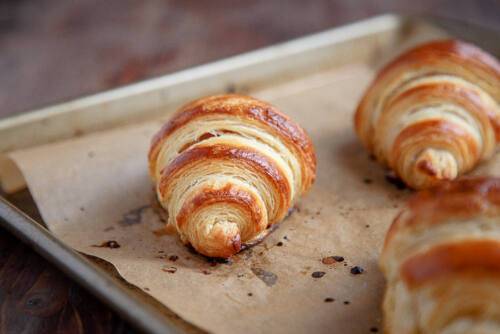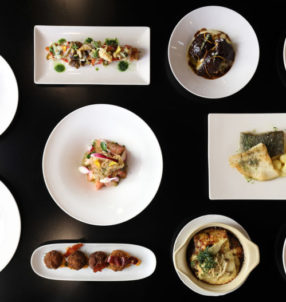By Helen Westwater
La Ola Fresca
So, while a well-known UK supermarket blows up a storm of scorn from the French…for launching a new, straight-lined croissant that is easier for their customers to spread with butter and jam…we get back to basics, roll up the shirtsleeves and make our own. With these utterly buttery croissants, you won’t need extra butter and can hence avoid the daunting issue of negotiating the crescent shape! January 30th is ‘National Croissant Day’ or #diainternacionaldelcroissant.
It seems the origin of the croissant was its ancestor, the kipferl, about which there are fanciful tales going back as far as 732 AD. One story is that it was invented in Europe to celebrate the defeat of Islamic forces and the crescent form is a reference to the Ottoman flag. However, the adaptation of the plainer form of kipferl is easier to trace and dates to 1839 at the latest. This was when an Austrian artillery officer with the formidable name of August Zang founded a Viennese bakery at 92 Rue de Richelieu in Paris and the popularity of the Viennese speciality took off.
The non-machine version requires many hours of labour, but once you have been through this workout, you can at least console yourself with the fact that you have burnt off some of the calories contained in that fragrant, flaky and freshly baked delight that now lies before you.
There are various arguments for using strong or plain flour but, although plain is easier to knead, the structure of the croissant with strong flour will be more airy. The origin of this particular croissant recipe is adapted from the cookery writer, James Martin.
Start the day before you want to eat your croissants!
First take 2 packets of butter (500 gm) out of fridge to allow to soften.
Mix the flour, sugar, yeast and salt and then add 350-400 ml (12-14 oz) cold water. Mix together to form a soft dough.
On a lightly floured surface, knead the dough till silky and soft (about 10 minutes). To do this, push your fist into the dough, turn the dough 1/4 rotation and then stretch the dough away from you and repeat, rotating the dough after every push. Leave to rest.
Next, place your chilled but not completely hard butter between two sheets of greaseproof paper. Then the fun begins. Roll, smack and do anything you can to flatten the butter until it is about a 30 x 20cm (12 x 8in) rectangle, about 1cm (1⁄2in) thick. Return to chill in the fridge until needed.
Turn the dough out again onto a lightly floured work surface. Roll it into a rectangle 60 x 30cm (24 x 12in).
Peel the greaseproof paper from the butter and place the butter centrally on top of the pastry rectangle. Fold one edge of the pastry over the butter to half-cover it, and then do the same with the other edge of the pastry so that the butter is covered. Fold the rectangle, side to side, lengthways as before, then give it a quarter-turn and roll out again to a rectangle measuring 60 x 30cm (24 x 12in).
Repeat the folding, turning and rolling process three more times (do not roll out the pastry the final time you fold and turn it). Wrap the pastry in cling film and chill in the fridge for at least an hour or preferably overnight.
When the pastry has rested, roll it out to a thickness of 0.5cm (1⁄4in). Cut the pastry into two 50 x 20cm (20 x 8in) strips, then cut each strip into triangles about 10cm (4in) wide at the base.
With the narrow point of one of the pastry triangles facing away from you, use your fingertips to stretch the two points of the triangle nearest to you out sideways so that they bow a little.
Roll the pastry over itself, curling it into a traditional crescent shape, so that the furthest and thinnest point of the triangle ends up curled over the top of the croissant. Repeat the process with the remaining pastry triangles to create about 20 croissants.
Place the croissants onto baking trays lined with silicone paper or baking parchment. Brush them all over with the beaten egg, then set aside to prove for 30-45 minutes. (NB: The croissants can be frozen at this point if desired.)
Preheat the oven to 190C /170C Fan/ Gas 5. Bake the croissants for 20- 25 minutes, or until risen and golden brown.
Of course, if you don’t fancy doing the elbow work the best croissants you will find in Valencia are baked by the revered El Taller bakery in Benimaclet and if you hurry, you can be served these in La Ola Fresca at breakfast time.
CROISSANT
Ingredients
•625 gm (1lb 6oz) strong white bread flour, plus extra for dusting
•75 gm (21⁄2oz) caster sugar
•12 gm fine sea salt
•40 gm (11⁄2oz) fresh yeast
•500 gm (1lb 2oz) chilled unsalted
butter, plus extra to serve
•1 free-range egg and 1 egg yolk, lightly beaten
Article copyright Helen Westwater of ‘La Ola Fresca’ / ’24/7 Valencia’
La Ola Fresca
C/ Músico Magenti, 11
Tel.: 610 026 305
https://www.facebook.com/LAOLAFRESCA
Zona Benimaclet
Related Post
This site uses Akismet to reduce spam. Learn how your comment data is processed.

























Leave a comment